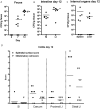Mucin dynamics in intestinal bacterial infection
- PMID: 19088856
- PMCID: PMC2601037
- DOI: 10.1371/journal.pone.0003952
Mucin dynamics in intestinal bacterial infection
Abstract
Background: Bacterial gastroenteritis causes morbidity and mortality in humans worldwide. Murine Citrobacter rodentium infection is a model for gastroenteritis caused by the human pathogens enteropathogenic Escherichia coli and enterohaemorrhagic E. coli. Mucin glycoproteins are the main component of the first barrier that bacteria encounter in the intestinal tract.
Methodology/principal findings: Using Immunohistochemistry, we investigated intestinal expression of mucins (Alcian blue/PAS, Muc1, Muc2, Muc4, Muc5AC, Muc13 and Muc3/17) in healthy and C. rodentium infected mice. The majority of the C. rodentium infected mice developed systemic infection and colitis in the mid and distal colon by day 12. C. rodentium bound to the major secreted mucin, Muc2, in vitro, and high numbers of bacteria were found in secreted MUC2 in infected animals in vivo, indicating that mucins may limit bacterial access to the epithelial surface. In the small intestine, caecum and proximal colon, the mucin expression was similar in infected and non-infected animals. In the distal colonic epithelium, all secreted and cell surface mucins decreased with the exception of the Muc1 cell surface mucin which increased after infection (p<0.05). Similarly, during human infection Salmonella St Paul, Campylobacter jejuni and Clostridium difficile induced MUC1 in the colon.
Conclusion: Major changes in both the cell-surface and secreted mucins occur in response to intestinal infection.
Conflict of interest statement
Figures








References
-
- Tobe T, Sasakawa C. Species-specific cell adhesion of enteropathogenic Escherichia coli is mediated by type IV bundle-forming pili. Cell Microbiol. 2002;4:29–42. - PubMed
-
- Mundy R, MacDonald TT, Dougan G, Frankel G, Wiles S. Citrobacter rodentium of mice and man. Cellular Microbiology. 2005;7:1697–1706. - PubMed
-
- MacDonald TT, Frankel G, Dougan G, Goncalves NS, Simmons C. Host defences to Citrobacter rodentium. Ijmm International Journal of Medical Microbiology. 2003;293:87–93. - PubMed
-
- McGuckin MA, Every A, Skene C, Linden S, McAuley J, et al. Muc1 mucin limits both Helicobacter pylori colonization of the murine gastric mucosa and the associated gastritis. Gastroenterology. 2007;133:1210–1218. - PubMed
Publication types
MeSH terms
Substances
LinkOut - more resources
Full Text Sources
Research Materials
Miscellaneous

